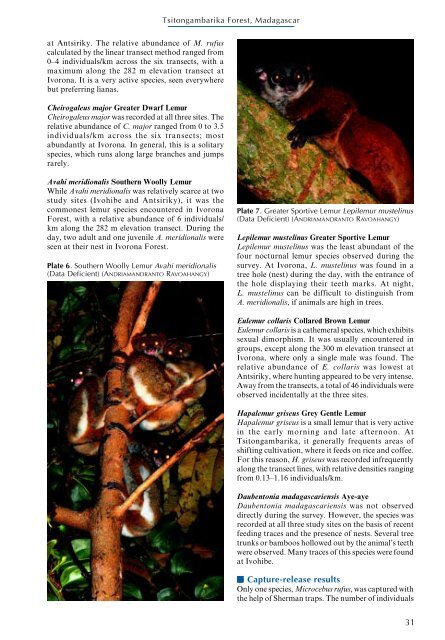TSITONGAMBARIKA FOREST, MADAGASCAR - BirdLife International
TSITONGAMBARIKA FOREST, MADAGASCAR - BirdLife International
TSITONGAMBARIKA FOREST, MADAGASCAR - BirdLife International
You also want an ePaper? Increase the reach of your titles
YUMPU automatically turns print PDFs into web optimized ePapers that Google loves.
at Antsiriky. The relative abundance of M. rufus<br />
calculated by the linear transect method ranged from<br />
0–4 individuals/km across the six transects, with a<br />
maximum along the 282 m elevation transect at<br />
Ivorona. It is a very active species, seen everywhere<br />
but preferring lianas.<br />
Cheirogaleus major Greater Dwarf Lemur<br />
Cheirogaleus major was recorded at all three sites. The<br />
relative abundance of C. major ranged from 0 to 3.5<br />
individuals/km across the six transects; most<br />
abundantly at Ivorona. In general, this is a solitary<br />
species, which runs along large branches and jumps<br />
rarely.<br />
Avahi meridionalis Southern Woolly Lemur<br />
While Avahi meridionalis was relatively scarce at two<br />
study sites (Ivohibe and Antsiriky), it was the<br />
commonest lemur species encountered in Ivorona<br />
Forest, with a relative abundance of 6 individuals/<br />
km along the 282 m elevation transect. During the<br />
day, two adult and one juvenile A. meridionalis were<br />
seen at their nest in Ivorona Forest.<br />
Plate 6. Southern Woolly Lemur Avahi meridionalis<br />
(Data Deficient) (ANDRIAMANDRANTO RAVOAHANGY)<br />
Tsitongambarika Forest, Madagascar<br />
Plate 7. Greater Sportive Lemur Lepilemur mustelinus<br />
(Data Deficient) (ANDRIAMANDRANTO RAVOAHANGY)<br />
Lepilemur mustelinus Greater Sportive Lemur<br />
Lepilemur mustelinus was the least abundant of the<br />
four nocturnal lemur species observed during the<br />
survey. At Ivorona, L. mustelinus was found in a<br />
tree hole (nest) during the day, with the entrance of<br />
the hole displaying their teeth marks. At night,<br />
L. mustelinus can be difficult to distinguish from<br />
A. meridionalis, if animals are high in trees.<br />
Eulemur collaris Collared Brown Lemur<br />
Eulemur collaris is a cathemeral species, which exhibits<br />
sexual dimorphism. It was usually encountered in<br />
groups, except along the 300 m elevation transect at<br />
Ivorona, where only a single male was found. The<br />
relative abundance of E. collaris was lowest at<br />
Antsiriky, where hunting appeared to be very intense.<br />
Away from the transects, a total of 46 individuals were<br />
observed incidentally at the three sites.<br />
Hapalemur griseus Grey Gentle Lemur<br />
Hapalemur griseus is a small lemur that is very active<br />
in the early morning and late afternoon. At<br />
Tsitongambarika, it generally frequents areas of<br />
shifting cultivation, where it feeds on rice and coffee.<br />
For this reason, H. griseus was recorded infrequently<br />
along the transect lines, with relative densities ranging<br />
from 0.13–1.16 individuals/km.<br />
Daubentonia madagascariensis Aye-aye<br />
Daubentonia madagascariensis was not observed<br />
directly during the survey. However, the species was<br />
recorded at all three study sites on the basis of recent<br />
feeding traces and the presence of nests. Several tree<br />
trunks or bamboos hollowed out by the animal’s teeth<br />
were observed. Many traces of this species were found<br />
at Ivohibe.<br />
■ Capture-release results<br />
Only one species, Microcebus rufus, was captured with<br />
the help of Sherman traps. The number of individuals<br />
31

















